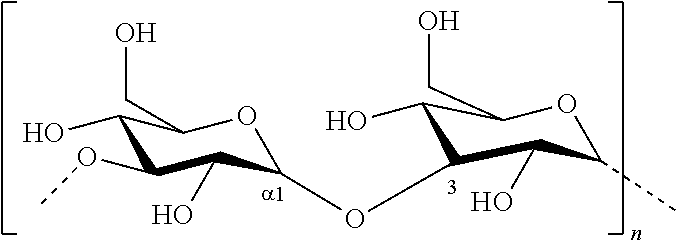Process for producing alpha-1,3-glucan polymer with reduced molecular weight
a technology of alpha-1,3-glucan and polymer, which is applied in the field of enzymatic processes, can solve the problems that starch or amylose consisting of alpha-1,4-linked glucose is not useful for fiber applications, and achieve the effect of reducing the molecular weight of the poly alpha-1,3-glucan produced in the contact step
- Summary
- Abstract
- Description
- Claims
- Application Information
AI Technical Summary
Benefits of technology
Problems solved by technology
Method used
Image
Examples
example 1
Glucan Polymerization Reactions Using gtfJ Enzyme and Polar Organic Solvents
[0097]This Example describes producing alpha-1,3-glucan in gtf-catalyzed reactions containing polar organic solvent. Specifically, this example shows that including a polar organic solvent (10 vol %) in a gtf reaction solution reduces the molecular weight of alpha-1,3-glucan synthesized by the reaction. The gtf in this Example was the S. salivarius gtfJ enzyme (SEQ ID NO:2).
[0098]The desired amount of sucrose was weighed out and diluted up to 90 mL using deionized water. 10 mL of either a polar organic solvent (see Table 2) or water (control) was then added to bring the total volume to 100 mL. The polar organic solvent used was methanol, methyl formamide, ethanol, DMSO, i-propanol, t-butanol, n-propanol, acetone, formamide, acetonitrile, N,N-dimethylformamide, N,N-dimethylacetamide, tetrahydrofuran, propylene carbonate, or sulfolane. Each solution was next transferred to a 125-mL glass bottle equipped with a...
example 2
Glucan Polymerization Reactions Using qtfJ Enzyme and Acetonitrile
[0105]This Example describes producing alpha-1,3-glucan in gtf-catalyzed reactions containing the aprotic polar organic solvent, acetonitrile. Specifically, this example shows that increasing levels of acetonitrile lead to greater reductions in polymer molecular weight, and that acetonitrile can reduce the molecular weight of polymer produced in reactions at 37° C.
[0106]The procedure described in Example 1 was followed to prepare S. salivarius gtfJ (SEQ ID NO:2) reaction solutions containing acetonitrile. However, the amount of acetonitrile added to the reaction solution was varied from 2-20 mL (for 2, 10, or 20 vol % acetonitrile); the amount of water was adjusted accordingly to maintain a total reaction volume of 100 mL. The results of these reactions are provided in Table 3.
[0107]
TABLE 3Molecular Weight of alpha-1,3-Glucan Polymer Produced inReaction Solutions Containing Various Amounts of AcetonitrileInitialTemper...
example 3
Glucan Polymerization Reactions Using Various gtf Enzymes
[0113]This Example describes producing alpha-1,3-glucan in reactions containing a polar organic solvent and different gtf enzymes. Specifically, this example shows that, in addition to SEQ ID NO:2, other types of gtf enzymes can be used in reactions containing acetonitrile to produce glucan polymer with reduced molecular weight.
[0114]The gtf enzymes used in this example were as follows:
[0115]The S. salivarius gtfJ enzyme was SEQ ID NO:2, encoded by SEQ ID NO:1.
[0116]An N-terminally truncated version of a Streptococcus sobrinus gtf enzyme identified in GENBANK under GI number 450874 was used (SEQ ID NO:4, encoded by SEQ ID NO:3; herein referred to as “0874”).
[0117]An N-terminally truncated version of Streptococcus salivarius K12 gtf enzyme identified in GENBANK as a dextransucrase under GI number 400182678 was used (SEQ ID NO:6, encoded by SEQ ID NO:5; herein referred to as “2678”).
[0118]An N-terminally truncated version of Str...
PUM
| Property | Measurement | Unit |
|---|---|---|
| temperature | aaaaa | aaaaa |
| concentration | aaaaa | aaaaa |
| temperatures | aaaaa | aaaaa |
Abstract
Description
Claims
Application Information
 Login to View More
Login to View More - R&D
- Intellectual Property
- Life Sciences
- Materials
- Tech Scout
- Unparalleled Data Quality
- Higher Quality Content
- 60% Fewer Hallucinations
Browse by: Latest US Patents, China's latest patents, Technical Efficacy Thesaurus, Application Domain, Technology Topic, Popular Technical Reports.
© 2025 PatSnap. All rights reserved.Legal|Privacy policy|Modern Slavery Act Transparency Statement|Sitemap|About US| Contact US: help@patsnap.com

